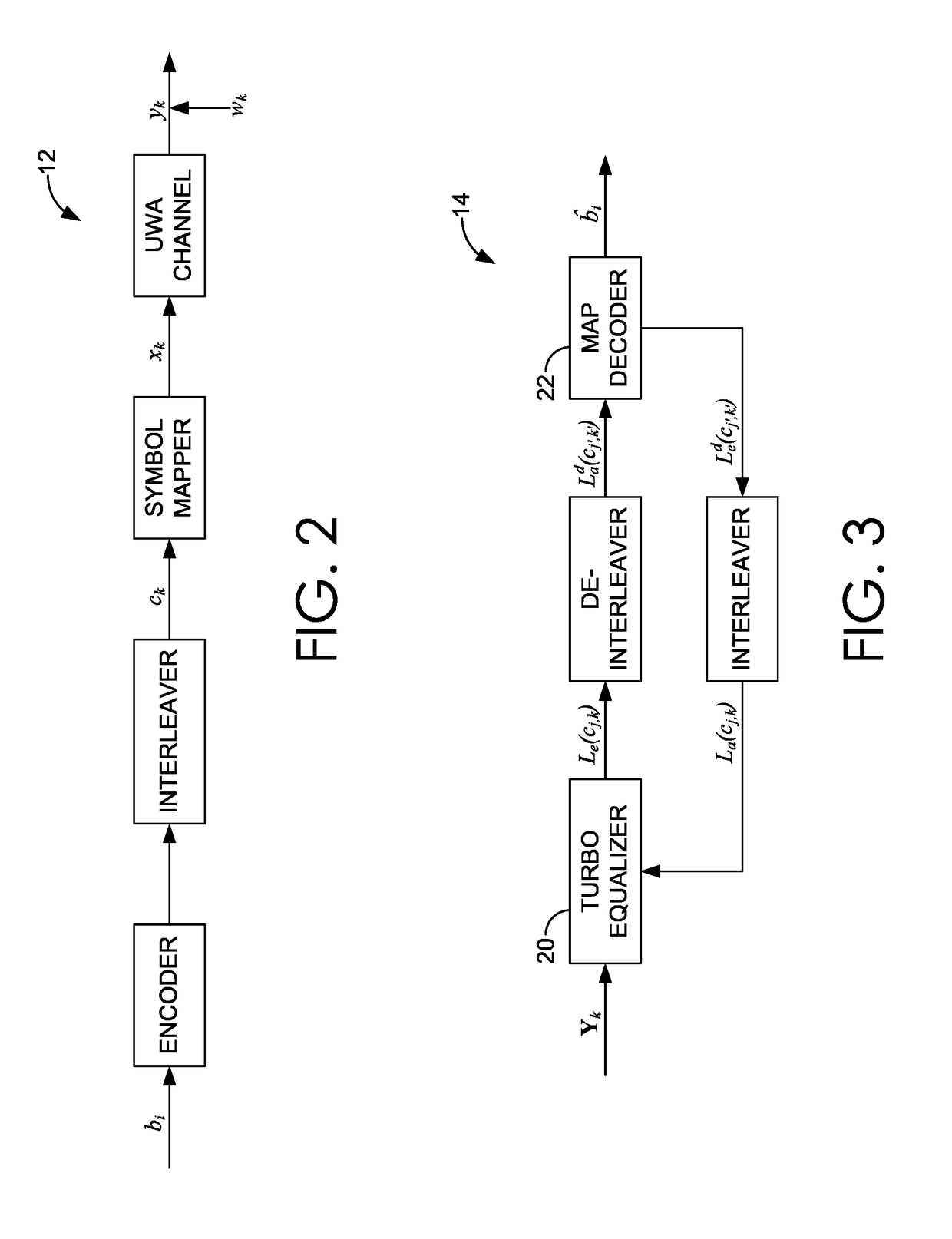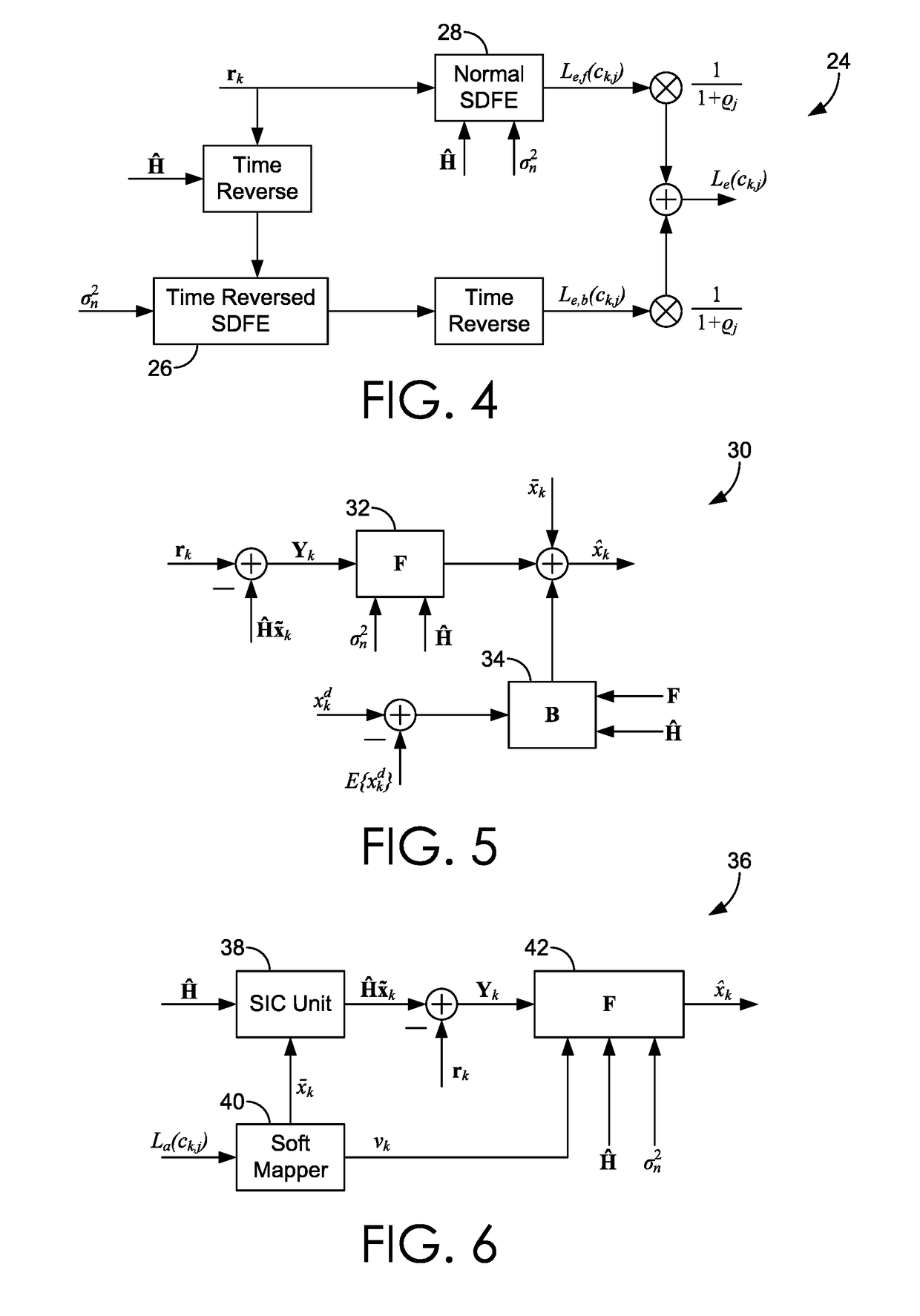Turbo receivers for single-input single-output underwater acoustic communications
a receiver and underwater acoustic technology, applied in the field of underwater acoustic communication receivers, can solve the problems of echoes and signal interference, difficult selection of modulation and error correction techniques, so as to improve the robustness and performance of the receiver, improve the uwa communication system, and increase reliability
- Summary
- Abstract
- Description
- Claims
- Application Information
AI Technical Summary
Benefits of technology
Problems solved by technology
Method used
Image
Examples
second embodiment
[0045]In a second embodiment, the turbo equalizer 20 may comprise a CE-based SDFE. For example, the CE-based SDFE may comprise the exemplary SDFE 30 discussed above in reference to FIG. 5. An estimated symbol {circumflex over (x)}k may be determined by equation (6) where F is the feedforward filter, B is the feedback filter of length K3=K2+L−1, and dk is the time-varying offset. The input vector of the feedback filter is defined by equation (7) where xkd is the a posteriori soft decision estimated by combining the a priori LLRs La (ck,j) and bit extrinsic LLRs Le(ck,j). The filters in the exemplary SDFE 30 at each turbo iteration are determined by equations (8a)-(8c) below, where Cff, Cfb and Cbb are the covariance matrices.
FH=[σw2IK+Ĥ(Cff−Cfb(Cbb)−1CfbH)ĤH]−1 (8a)
BH=−(Cbb)−1ĤCfbHFH (8b)
dk=E{xk}−FĤE{xk}−BE{xkd} (8c)
The covariance matrices Cff, Cfb, and Cbb are defined by equations (9a)-(9c) below.
Cff=E{xkxkH}−E{xk}E{xkH} (9a)
Cfb=E{xkxkdH}−E{xk}E{xkdH} (9b)
Cbb=E{xkdxkdH}−E{xd}E{...
third embodiment
[0046]In a third embodiment, the turbo equalizer 20 may comprise a CE-based LMMSE turbo equalizer that estimates the transmitted symbol {circumflex over (x)}k using the received signal rk and the a priori LLRs La (ck,j) provided by the MAP decoder 22. Turning to FIG. 6, with continuing reference to FIG. 3, a block diagram of an exemplary CE-based LMMSE turbo equalizer 36 is depicted. The exemplary CE-based LMMSE turbo equalizer 36 includes a serial interference cancellation (“SIC”) unit 38, a soft mapper 40, and a feedforward filter 42. The a priori information La (ck,j) is provided to the soft mapper 40, which uses the a priori LLRs La(ck,j) to compute an a priori soft decision 4. The a priori soft decision may be determined by equations (10) and (11) below.
x_k=E[xk|{La(ck,j)}j=1Q]=∑αi∈SαiP(xk=αi)where(10)P(xk=αi)=∏j=1q12(1+s~i,jtanh(La(ck,j) / 2))ands~i,j={+1ifsi,j=0-1ifsi,j=1.(11)
The a priori soft decision xk is fed into the SIC unit 38 along with an estimated channel Ĥ and a recon...
fourth embodiment
[0048]In a fourth embodiment, the turbo equalizer 20 may comprise a Soft DA-TEQ that estimates the transmitted symbol {circumflex over (x)}k using the received signal rk and the a priori soft decisions La(ck,j) provided by the MAP decoder 22. Turning now to FIG. 7, a block diagram of a turbo receiver having an exemplary Soft DA-TEQ 44 is depicted. The exemplary Soft DA-TEQ includes a feedforward filter 46 and a soft interference cancellation filter 48. The estimated transmitted symbol {circumflex over (x)}k may be determined with equation (14) below, where Fk is the feedforward filter and Bk is the soft interference cancellation filter.
{circumflex over (x)}k=FkHrk+BkH{tilde over (x)}k (14)
[0049]Equation (13) can be reformulated as {circumflex over (x)}k=GkHUk, where Gk=[FkT BkT]T is the concatenation of the feedforward and soft interference filters, and Uk=[rkT {tilde over (x)}kT]T is the overall input of said filters. The equalizer coefficients may be directly estimated by the DA-...
PUM
 Login to View More
Login to View More Abstract
Description
Claims
Application Information
 Login to View More
Login to View More - R&D
- Intellectual Property
- Life Sciences
- Materials
- Tech Scout
- Unparalleled Data Quality
- Higher Quality Content
- 60% Fewer Hallucinations
Browse by: Latest US Patents, China's latest patents, Technical Efficacy Thesaurus, Application Domain, Technology Topic, Popular Technical Reports.
© 2025 PatSnap. All rights reserved.Legal|Privacy policy|Modern Slavery Act Transparency Statement|Sitemap|About US| Contact US: help@patsnap.com



